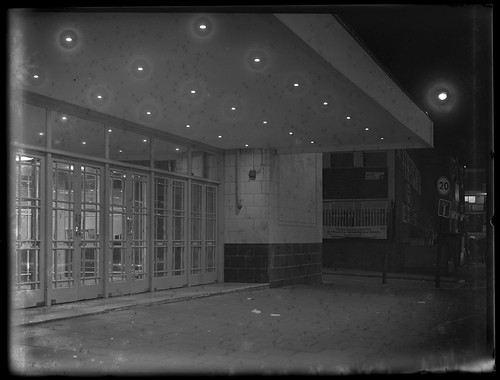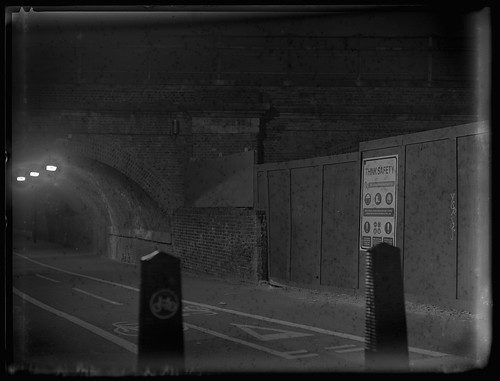 |
| Adaptors to use 10.8x6cm glass plates in 4x5 inch plateholders |
In my last post,
'Some odd-sized glass plates', I wrote about making adaptors to shoot the 10.8x6cm HP3 glass plates in 4x5 inch plateholders; a comment on the post about the passing reference to making the adaptors has provoked me to illustrate them.
 |
| Adaptor diagram (to scale at 96 dpi) |
I used mountcard of the sort that should be found in any good arts and crafts suppliers. The mountcard itself is roughly 1.5mm thick. The adaptors are made from two pieces of card glued together with PVA glue. The lower piece of card, shown in green outlines above, is the dimensions of a 4x5 glass plate, with an aperture cut in the centre to fit the plates in. The upper piece of card, in red, has a smaller aperture, 2mm narrower on each side, which provides a lip to hold the plate in place. In terms of the thickness of the adaptor as a whole, there's enough clearance with the plateholder's darkslide that the additional height does not interfere with sliding the darkslide in and out. The emulsion surface of the glass plate should be level to the plane of focus, being held in place by the curved spring from behind and flush with the surface of the lower piece of card, which itself should be held exactly as a 4x5 plate would be. Importantly, the upper piece is reduced in length so that either end of the adaptor fits under each end of the plateholder. I've found that plateholders do vary a small amount in their tolerances: the above diagram fits Type II plate holders by Folmer Graflex Corp. The 5mm difference between the upper and lower pieces at the right end of the diagram above fits under the top end of the plateholder, the 3mm end fits under the lower (folding) end of the plateholder, as shown in the image below (rotated 180º, so the folding end of the holder is on the right in the picture).
 |
| Adaptor in 4x5 Folmer Graflex Plateholder |
The mountcard was painted with black acrylic paint to give a matte finish, and I also numbered the adaptors with small notches in one corner, to identify which plates were shot in which holders, not entirely necessary, but potentially useful.
 |
| Detail with numbering notches (underside) |
I also made some adaptors to use quarterplate-sized plates in 4x5 holders, with the same method of contstruction, which, although I could shoot in my
Ensign Folding Klito, meant I could use the lenses and movements of the
MPP Micro-Technical Mk VI with the effect of a small amount of cropping. As well as these technical considerations, the fact that glass plates in the quarterplate size (4 1/4 x 3 1/4, or 10.8x8.2cm) appear to be most abundant, it seemed wise to able to shoot this size in more than just one camera (the first couple of results with 1940s Ilford HP3 plates are below).
 |
Ilford HP3 4 1/4 x 3 1/4 inch glass plate.
Shot with MPP Micro-Technical Mk VI using adaptor. |
 |
Ilford HP3 4 1/4 x 3 1/4 inch glass plate.
Shot with MPP Micro-Technical Mk VI using adaptor. |






Excellent, thanks for this - I will try this. Up to now I have been sticking plates in with masking tape!
ReplyDeleteI did successfully make one of these, and fitting the plates in daylight is reasonably easy but in the dark it is very fiddly because the plate has to be underneath and loose so to speak - any tips?
ReplyDeleteThat's a very good point, and one that I didn't expand upon. Sometimes when the plates are tight in the adaptors they'll just stay put when loading, but generally I will actually place the plate in the adaptor upside down - and load the plate holder upside down, so that gravity keeps the plate in place.
DeleteHaving made two of the adapters, I used them to shoot two Ilford N.40 Process plates with an MPP MkVIII, and they were almost perfect, just a few pinholes, but otherwise excellent, rated at 10iso, and processed in HC110b for 5 mins. Were process plates originally for copying documents? These seem to be from 1958 if the code on the info sheet is anything to go by.
ReplyDeleteAccording to the Ilford Manual of Photography, Process plates were 'for process work, copying black-and-white originals, etc. Very suitable for the making of screen negatives'. I've only shot a few N.40 plates, they seem to be high contrast but have aged very well.
Delete